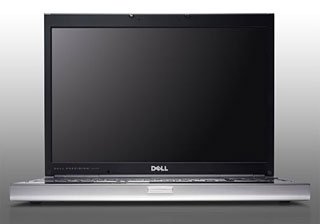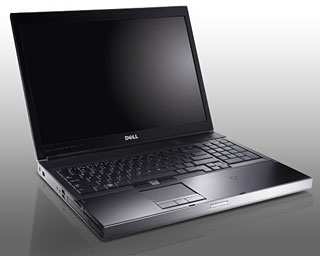Laptops with 17" or larger displays probably don't make the best of
sense as road warrioring machines, although my 17" PowerBook has
surprised me with how amenable it's been to being taken along on road
trips (in a very nice Waterfield Racer X case), and I've even used it
in the car without much difficulty.
It's not as handy as my old 12" iBook was for
such use, but it compares reasonably well with my current "road" 'Book
- one of my old G4-upgraded Pismo PowerBooks. It's actually
not much heavier than the Pismo, and I don't find the wide footprint a
problem for literal laptop use.
Airline seat trays would be a different story of course.
However, where the 17-incher shines is as a desktop substitute
workstation that also can be conveniently and self-containedly portable
when the occasion arises. I think a case can be made for even larger
portable computers, not necessarily with a larger screen than 17", but
rather with more physical bulk, expandability, and internal capacity -
and a full extended keyboard with a numeric keypad and full slate of
function/navigation keys - a true desktop substitute.
The 17" PowerBook and MacBook Pro are
wonderful computers that make more satisfactory dual-purpose laptops
than their ample footprints imply, but their 1" thick form factor
compromises function and features potential, Returning to the two inch
plus housing thickness that used to be the norm would open up a whole
new vista of practical power, function, and expansion potential, as
well as making the cooling problem more tractable.
Last week Dell introduced such a machine, and I have to say it has
me drooling a bit.
The great big desktop substitute laptop is a category I have to
concede that some of the PC makers have covered better than Apple, at
least since the demise of the old PowerBook G3 Series WallStreet
PowerBook ten years ago - a machine that marked the high-water mark
for Apple in versatility, connectivity, and road-hugging weight.
Recently the availability of quad-core Intel mobile processors has
catalyzed some speculation and dreaming as to whether Apple might be
persuaded to build a really big MacBook Pro, quad-powered and possibly
with an 18" or 19" display. Frankly, I think that's an extreme long
shot, as much as such a machine would appeal to me.
 But last week Dell unveiled its new flagship
Precision M6400 workstation notebook, which is available with
optional Intel 2.53 GHz Core 2 Quad QX9300 QuadCore Extreme Edition
processors, up to 16 GB of fast 1066 MHz Dual Channel DDR3 Memory, and
up to 1 GB of dedicated VRAM. That spec certainly gets my
attention. Hard drives are available up to 500 GB, and there is also a
128 GB Solid State Drive (SSD) option.
But last week Dell unveiled its new flagship
Precision M6400 workstation notebook, which is available with
optional Intel 2.53 GHz Core 2 Quad QX9300 QuadCore Extreme Edition
processors, up to 16 GB of fast 1066 MHz Dual Channel DDR3 Memory, and
up to 1 GB of dedicated VRAM. That spec certainly gets my
attention. Hard drives are available up to 500 GB, and there is also a
128 GB Solid State Drive (SSD) option.
Other high-end options for the M6400 include RAID 0 storage
performance and powerful Nvidia Quadro FX graphics processor units.
Designed uncompromisingly to be a portable workstation, weighing in at
a base of 8.5 pounds, although still an easy to handle 1.35" to 1.5"
thickness. Width and depth are 15.4" and 11.0 respectively.
For some comparative perspective, the 17" MacBook Pro's footprint is
15.4 " x 10.4", and it's considerably lighter at 6.8 pounds. The
M6400's weight is nearly two pounds heavier than the Apple 17-incher
and a bit more than half a pound heavier than the heaviest WallStreets
(7.8 lb.), although the Dell is half an inch or more thinner than the
WallStreets (but of course wider). It's apparently thick enough for
reasonably decent cooling. Dell says the M6400 has the thermal headroom
to deliver certified ISV application performance levels.
 The M6400s impressive memory expandability up to 16 GB (4x what
the MacBook Pro supports) is thanks to Intel's Q43 mobile chipset,
which provides support for four DDR3 memory slots that can each support
4 GB of memory, taking the RAM ceiling up to a desktop-like 16 GB.
And with two dedicated hard drive bays, internal storage capacity can
scale up to 1 TB, plus the machine's eSATA interface enables you
to directly connect external SATA hard drives.
The M6400s impressive memory expandability up to 16 GB (4x what
the MacBook Pro supports) is thanks to Intel's Q43 mobile chipset,
which provides support for four DDR3 memory slots that can each support
4 GB of memory, taking the RAM ceiling up to a desktop-like 16 GB.
And with two dedicated hard drive bays, internal storage capacity can
scale up to 1 TB, plus the machine's eSATA interface enables you
to directly connect external SATA hard drives.
The M6400 has a handsome (IMHO) aluminum chassis (for a nice gallery
of shots of the aptly-named M6400 "Covet" version in a fetching shade
of Autumn "flame orange", click
this link.
The standard 17" display has a 1440 x 900 resolution, which is the
same as the 15" MacBook Pro and older 17" PowerBooks like mine, but an
optional RGB LED edge-to-edge 1920x1200 17" screen with 100% Adobe
color gamut support is optional for $159 extra, as are a slot-loader
optical drive, optional dual array microphones, and an optional
2 MP camera plus a media card reader.
 The backlit keyboard makes much better and more sensible use of
a 17" laptop's necessary width by incorporating a full extended
keyboard with dedicated number pad. Given the vast expanse of plain
metal on either side of the Apple 17-inchers' keyboard, I've wondered
why they didn't take advantage of the ample width. Extended keyboards
in laptops do impose asymmetry and an off-center orientation for the
main keyboard, so aesthetics (again, sigh) may be the sticking point
here.
The backlit keyboard makes much better and more sensible use of
a 17" laptop's necessary width by incorporating a full extended
keyboard with dedicated number pad. Given the vast expanse of plain
metal on either side of the Apple 17-inchers' keyboard, I've wondered
why they didn't take advantage of the ample width. Extended keyboards
in laptops do impose asymmetry and an off-center orientation for the
main keyboard, so aesthetics (again, sigh) may be the sticking point
here.
One thing the M6400 isn't, however, is cheaper than a 17" MacBook
Pro. Well, strictly speaking the base price does start at $100 less
($2,599), but that's for a modest configuration with a 2.26 GHz Core 2
Duo, 1 GB of memory, an 80 GB hard drive, a CD-RW/DVD combo drive,
and a 512 MB Quadro FX 2700M GPU, which doesn't come close to matching
the 17" MacBook Pro's standard configuration.
In this particular saw-off, the MacBook Pro is actually the bargain
leader, but it's with its expandability that the M6400 breaks out in
front and leaves the MacBook Pro in its dust, albeit at a price. The
quad-core version starts at a suck-in-your-breath $3,499 and escalates
from there as you go through the option list into the price
stratosphere once inhabited by high-end PowerBooks back in the day.
Sigh.
For me, the price and the M6400's inability to (legally) support the
Mac OS are deal-breakers.
So what would a serious desktop substitute workstation laptop be
like? In a 17" PowerBook with a thicker case, there could be room for
two ExpressCard slots and a card reader. A couple of removable device
expansion/battery bays could be incorporated, as with the M6400 or the
old WallStreet. The more efficient cooling afforded by a larger, less
jam-packed case would facilitate incorporate faster dual-core and
quad-core processors and a bunch of RAM slots, while a full-sized,
105-key extended keyboard would enhance desktop-analog
functionality.
Another advantage of a big laptop with huskier dimensions would be
enhanced ruggedness. The aluminum PowerBooks and MacBook Pros are
reasonably rugged, but particular issue of concern is the rigidity - or
lack of in supporting those big, expansive (and expensive) screens.
Of course, such a machine as I've described it would be less
well-suited to true mobile computing than the 17" PowerBooks and
MacBook Pros.
However, for growing numbers of users who are opting for portables
as mostly desktop substitute computers, a 17" 'BigBook' computer would
make eminent good sense. There are lots of folks who really don't need
a true, lightweight road warrioring machine, but for whom the
compactness, portability, and battery power of a laptop still appeal.

 But last week Dell unveiled its new flagship
But last week Dell unveiled its new flagship  The M6400s impressive memory expandability up to 16 GB (4x what
the MacBook Pro supports) is thanks to Intel's Q43 mobile chipset,
which provides support for four DDR3 memory slots that can each support
4 GB of memory, taking the RAM ceiling up to a desktop-like 16 GB.
And with two dedicated hard drive bays, internal storage capacity can
scale up to 1 TB, plus the machine's eSATA interface enables you
to directly connect external SATA hard drives.
The M6400s impressive memory expandability up to 16 GB (4x what
the MacBook Pro supports) is thanks to Intel's Q43 mobile chipset,
which provides support for four DDR3 memory slots that can each support
4 GB of memory, taking the RAM ceiling up to a desktop-like 16 GB.
And with two dedicated hard drive bays, internal storage capacity can
scale up to 1 TB, plus the machine's eSATA interface enables you
to directly connect external SATA hard drives. The backlit keyboard makes much better and more sensible use of
a 17" laptop's necessary width by incorporating a full extended
keyboard with dedicated number pad. Given the vast expanse of plain
metal on either side of the Apple 17-inchers' keyboard, I've wondered
why they didn't take advantage of the ample width. Extended keyboards
in laptops do impose asymmetry and an off-center orientation for the
main keyboard, so aesthetics (again, sigh) may be the sticking point
here.
The backlit keyboard makes much better and more sensible use of
a 17" laptop's necessary width by incorporating a full extended
keyboard with dedicated number pad. Given the vast expanse of plain
metal on either side of the Apple 17-inchers' keyboard, I've wondered
why they didn't take advantage of the ample width. Extended keyboards
in laptops do impose asymmetry and an off-center orientation for the
main keyboard, so aesthetics (again, sigh) may be the sticking point
here.
